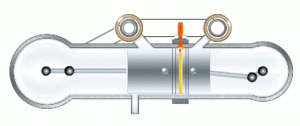Six-stroke engine
In the single-piston designs, the engine captures the heat lost from the four-stroke Otto cycle or Diesel cycle and uses it to drive an additional power and exhaust stroke of the piston in the same cylinder in an attempt to improve fuel efficiency and assist with engine cooling.
He wished to produce an internal combustion engine, but without paying the licensing costs of the Otto patents.
By 1886, Scottish steam locomotive maker Dick, Kerr & Co. saw a future in large oil engines and licensed the Griffin patents.
[2] A major market for the Griffin engine was in electricity generation, where they developed a reputation for happily running light for long periods, then suddenly being able to take up a large demand for power.
Their large, heavy construction did not suit them to mobile use, but they were capable of burning heavier and cheaper grades of oil.
The key principle of the "Griffin Simplex" was a heated, exhaust-jacketed external vapouriser, into which the fuel was sprayed.
This fractional distillation supported the use of heavy oil fuels, the unusable tars and asphalts separating out in the vapouriser.
[5] Leonard Dyer invented a six-stroke, internal combustion, water-injection engine in 1915, very similar to Crower's design (see below).
The valve overlaps have been removed, and the two additional strokes using air injection provide for better gas scavenging.
This engine was developed by Chanayil Cleetus Anil, of Cochin, India, who patented the design in 2012.
The engine underwent a preliminary round of full-throttle tests at the Automotive Research Association of India, Pune.
He claims that his design produces drastically less pollution and that use in the automotive industry could lead to "emission-less mobility."
Anil claims that this creates a fresher atmosphere inside the cylinder before the next air-fuel intake stroke, helps the engine to burn almost 100% of the air-fuel mixture, and reduces harmful emissions (including a 98% reduction in carbon monoxide emissions).
Thus, waste heat that requires an air or water cooling system to discharge in most engines is captured and put to use driving the piston.
[1] Crower estimated that his design would reduce fuel consumption by 40% by generating the same power output at a lower rotational speed.
[15] The idea was developed at the Silesian University of Technology, Poland, under the leadership of EngD Adam Ciesiołkiewicz.
In this engine, similar in design to the Beare head, a "piston charger" replaces the valve system.
The piston charger charges the main cylinder and simultaneously regulates the inlet and the outlet aperture, leading to no loss of air and fuel in the exhaust.
[17] In the main cylinder, combustion takes place every turn as in a two-stroke engine, while lubrication is achieved in the same manner as in a four-stroke.
Fuel injection can take place in the piston charger, in the gas-transfer channel or in the combustion chamber.
The benefit of fewer moving parts and design is claimed to lead to lower manufacturing costs.
The six strokes are: This is an invention of Helmut Kottmann from Germany, while working 25 years at MAHLE GmbH piston and cylinder construction.
An independent test measured the brake specific fuel consumption of Revetec's X4v2 prototype gasoline engine at 212g/kW-h[19] (corresponding to an energy efficiency of 38.6%).

